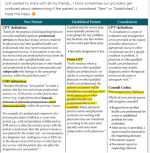The reason I'm confused is because I watched a Medicare webinar a while ago and there was a similar question asked. This was the question:
"We have NPs and PAs throughout our clinic, in urgent care, family medicine, dermatology. If a patient sees NP in urgent care or acute care and then sees our doctor in internal medicine, would that be a new patient to the doctor?"
Ellen: For initial services, Medicare uses the physician specialty the practitioner is enrolled under. A nurse practitioner enrolls as a nurse practitioner. They're not the same specialty as any doctor; therefore, yes, that doctor has an initial visit. Medicare does not use taxonomy codes. These codes allow the nurse practitioners to identify practice specialties.
CPT and CMS have differing definitions and payers may have their own rules too. However, after a little digging (MCR), looks like IF you know and can prove each has different specialty training AND the credentialing (NPI) aligns, you MAY be able to bill a new patient in your scenario for the NP (APRN?) (genetic) and the MD (depending on specialty designation). This is provided all of the other documentation requirements and rules, etc. etc. are met too. Who is your MAC? I would suggest looking there first. Then you would have to know how your providers are credentialed and what the specialty designation says.
Where was the webinar, do you have the link or transcript? In the question above they were talking about 1. NP Urgent Care and then 2. Doctor Internal Med. However, the term Urgent Care is not one of the listed Physician Specialty Codes here: 10.8.2 - Physician Specialty Codes
https://www.cms.gov/regulations-and-guidance/guidance/manuals/downloads/clm104c26pdf.pdf (93 Emergency Medicine is one).
https://www.aapc.com/blog/46341-same-physician-may-not-mean-what-you-think-it-does/

www.novitas-solutions.com
Office
1.
What is the difference between "new" and "established" patient and "new" and "established" problem? Does it mean the same for a non-physician practitioner (NPP)?
The terms "new" or "established" problem on the E/M score sheet refer to whether the problem is new or established to the examiner, e.g., physician/ NPP, and whether that problem is stable/worsening or whether the physician plans to conduct additional workup on that problem or not.
In CPT, a "new" patient is one who has not received any professional services from the physician/qualified health care professional or another physician/qualified health care professional of the same specialty and subspecialty who belongs to the same group practice, within the past three years.
An "established" patient is one who has received professional services from the physician/qualified health care professional or another physician/qualified health care professional of the same specialty and subspecialty who belongs to the same group practice, within the past three years.
CMS interprets the phrase “new patient” to mean a patient who has not received any professional services, i.e., E/M service or other face-to-face service (e.g., surgical procedure) from the physician or physician group practice (same physician specialty) within the previous 3 years. For example, if a professional component of a previous procedure is billed in a 3-year time period, e.g., a lab interpretation is billed and no E/M service or other face-to-face service with the patient is performed, then this patient remains a new patient for the initial visit. An interpretation of a diagnostic test, reading an x-ray or EKG etc., in the absence of an E/M service or other face-to-face service with the patient does not affect the designation of a new patient.
Currently, under the CMS enrollment process, NPPs cannot designate a sub-specialty. An NPP can only designate their primary licensure, e.g., nurse practitioner, physician assistant, certified nurse midwife, etc.
Reference
CMS IOM Pub. 100-04 Medicare Claims Processing Manual, Chapter 12, section 30.6
2.
We are seeing denials for our physician’s new patient visits indicating the patient was seen by our group in the last three years. Why is this occurring? What can we do about it?
In multispecialty groups, when an NPP sees the patient, this may cause your new patient visit to deny for a physician. If you can provide documentation that shows the NPP and physician are trained in different specialties, request a redetermination of the claim with the documentation.
A new patient is a patient who has not received any professional services, i.e., E/M service or other face-to-face service (e.g., surgical procedure) from the physician or physician group practice (same physician specialty) within the previous 3 years.
Currently, under the CMS enrollment process, NPPs cannot designate a sub-specialty. An NPP can only designate their primary licensure, e.g., nurse practitioner, physician assistant, certified nurse midwife, etc.
